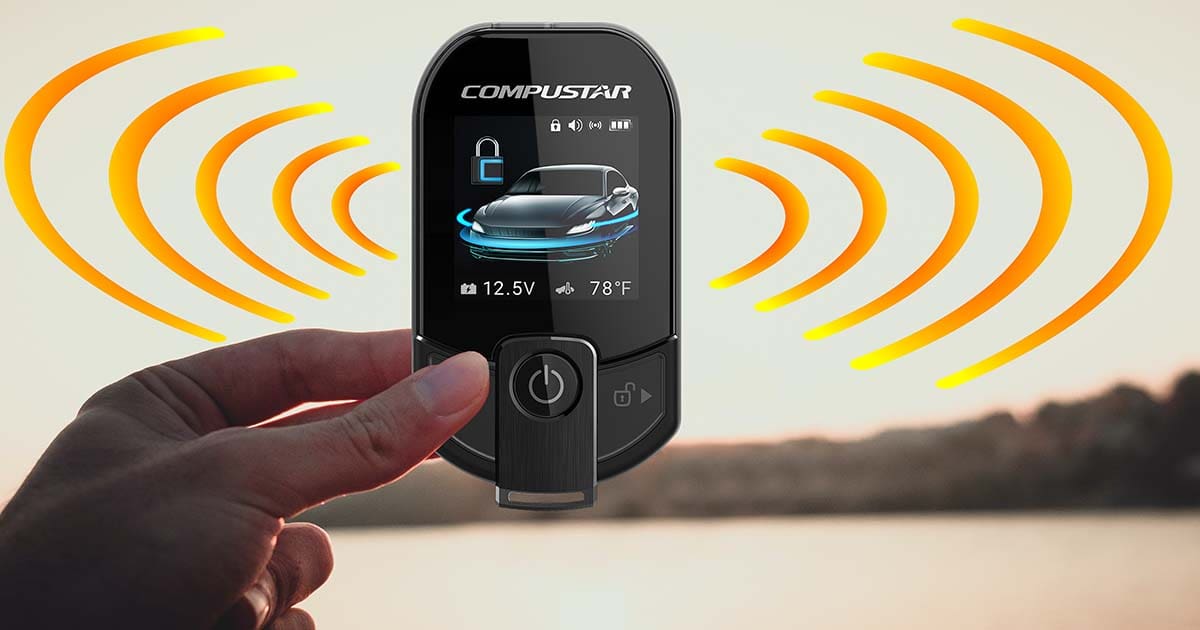If you ask anyone who’s had a remote starter or car alarm, they’ve likely heard of holding the remote to their chin to improve range. That’s right: With many of the classic key fobs, touching the remote to your chin while pressing the button can increase the signal strength and allow you to unlock, disarm or start the vehicle.
Because new car starter remotes use different communication frequencies and broadcast methods, the old chin trick doesn’t offer the same improvement that it did years ago. If you’ve got a basic remote, it’s worth a try, though. We set out to find some simple tricks that will add another 100 or 200 feet of distance from the vehicle where the system still works.
The Test Setup
We parked our 2015 Hyundai Genesis sedan in the same parking lot where we’ve done other range tests and set out to find ways of improving signal transmission performance. The vehicle is freshly equipped with a Compustar CM-X controller and one of the brand-new RFX-P2WT13-SF RF kits. This kit includes the new T13 and R5 long-range remotes and one of the DroneMobile X1-LTE telematic interfaces. The car also has the Compustar DAS-II security sensor that monitors the vehicle for impacts, glass breakage, motion or tilting.
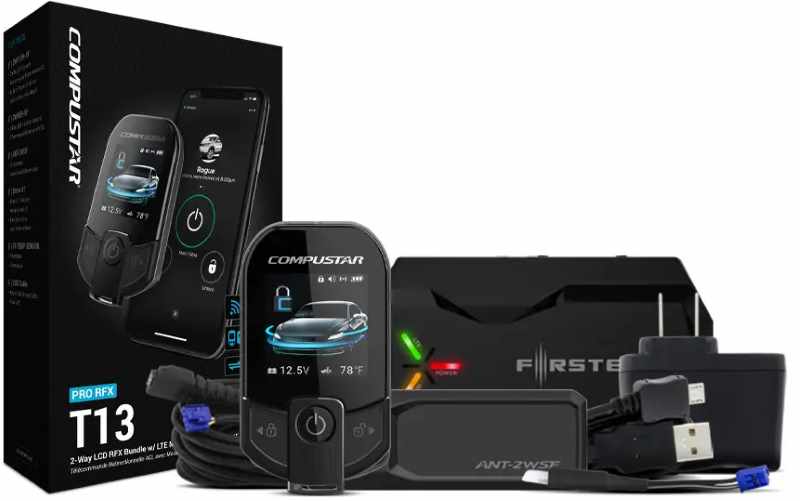
Compustar rates the R5 remote as offering up to 2 miles (3.2 kilometers) of range, and the T13 remote is rated for up to 3 miles (4.8 kilometers). These numbers, along with those provided by every remote start and security system manufacturer in the industry, are “ideal condition” specifications. What are ideal conditions? The vehicle would need to be somewhere that was flat and free of any type of obstruction – perhaps a desert? Likewise, there would need to be no other radio frequency broadcast in use in the same frequency range that the transmitters use. In any instance, be it in a city or the country, the effective range will be less.
For our test, we placed the car perpendicular to the direction we walked. We’ve tested a remote similar to the R5 in the past, and it worked to about three-quarters of a mile (3,850 feet or 1.17 kilometers) away. The new T13 remote improved that performance to deliver an impressive nine-tenths of a mile (4,700 feet or 1.44 kilometers) of range. Since radio frequency transmission power needs to be increased by a factor of 16 to double the effective range, our measured increase of 23% is truly impressive. Based on some very crude math, we’d estimate that the transmitter in the T13 is 1.5 times more powerful than the remote we tested previously.
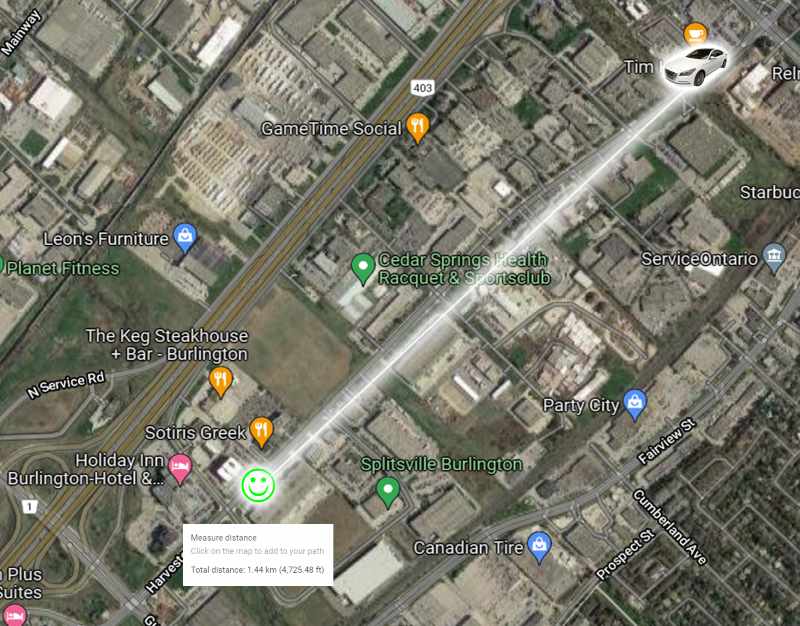
Let’s Talk about Radio Frequency Transmissions.
Before you ask why the range is less than claimed, let’s talk about a few things that affect radio frequency signal transmission. Any object – be it wood, metal, plastic or glass – absorbs radio frequency signals. We’ll start with glass. Yes, the windshield and side windows of the car reduce the effective range of the remote system. The Genesis sedan has fairly thick glass, so that’s going to reduce the signal a little bit more than, say, a Hyundai Accent would. If your windows are tinted with a metallic tint, that will dramatically reduce a signal’s ability to pass through. Our car has a nano-ceramic tint, so the effects are minimal. Next, there’s air itself. Humidity affects range. Your remote won’t work as well on a humid day as it will on a dry day. In our test, we had a creek between us and the vehicle. The creek was lined with trees, so those reduce the signal. Though the road was fairly straight, there was a slight curve at the third-of-a-mile (550-meter) mark. Not having a direct line of sight to the vehicle reduces range. There were at least four dozen businesses in industrial plazas between the car and where we finally ran out of range. While things like Wi-Fi operate on other frequencies, there is still radio frequency, or RF, energy in the air, and this can reduce the effective range.
Let’s talk about the six ways we tried to maximize the distance at which our remote starter works.
Remote Start Range Tip 1: Look at Me When I Talk to You
Because this was an experiment, it took some creativity to figure out what worked reliably and what didn’t. As we walked down the street, we’d try different tricks to reduce or increase range. The first thing we noticed is that it helped to face the vehicle. Every 50 or 100 feet, we’d stop and press the lock button and wait for the vehicle to respond. We noticed that the communication reliability improved if we faced the vehicle and held the remote in front of us. Since the human body is composed of about 60% water, it absorbs radio frequency energy quite effectively.
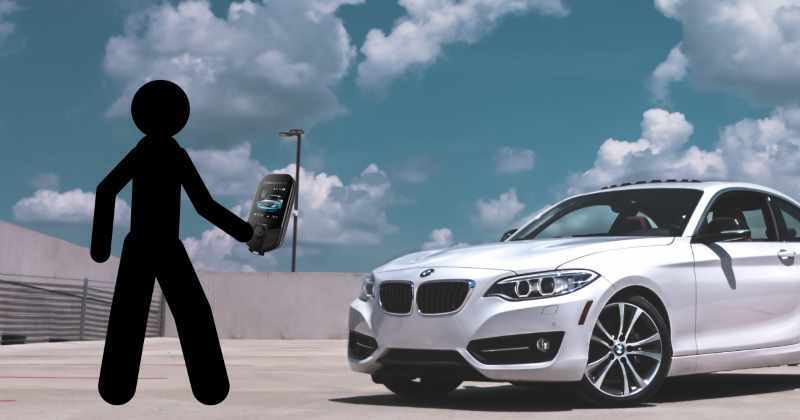
Remote Start Range Tip 2: Don’t Hide from Me
As we walked farther and farther from the car, we tried more experiments to see what helped and what hindered the communication ability. We noticed that the remote worked more reliably if we didn’t cradle it in our hands. Instead, if we pinched the remote, keeping our fingers away from the back of the unit, the range was improved. It looks quirky, but it definitely made a difference. We’ll call this method of holding the remote the Pinch Technique. In most remotes, the antenna is at the top of the case, so try to keep your fingers away from there.
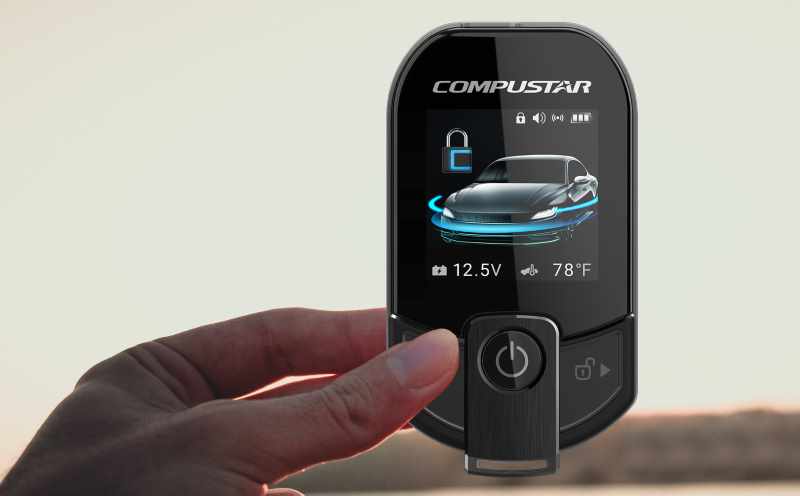
Remote Start Range Tip 3: Reach for the Stars!
We know people were looking at us with confusion as we’d walk 50 or 60 feet, turn around for 20 or 30 seconds, then walk another 50 feet and try the test again. We’re used to strange looks from people as we do this sort of testing. In fact, we’ve had police officers ask us what we were doing on more than one occasion while testing headlight adjustments and light measurements for other articles.
The next trick we found was to hold the remote up high over our head. The higher we reached, the better it worked. We combined this with the Pinch Technique, and we even tried holding the remote in different directions (with the screen or back to the vehicle) to optimize the operational distance.
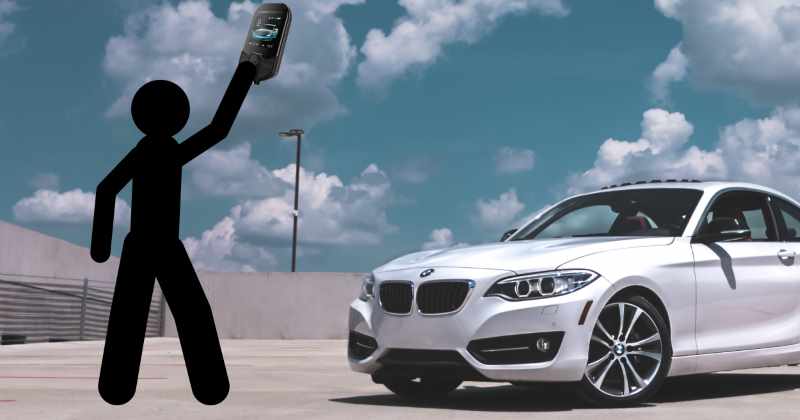
Remote Start Range Tip 4: Reduce Cellular Interference
When we were at the farthest distance where the vehicle would respond to the lock command, we tried turning off our iPhone 11. This had no effect on the range. With that said, T-Mobile in the U.S. does use what’s called LTE Band 26 for cellular uplink communications. This range of frequencies does overlap with the ~815 MHz transmission frequency used by these remotes. If your range is poor and you’re on T-Mobile, pop your phone into airplane mode for a moment to see if that helps.
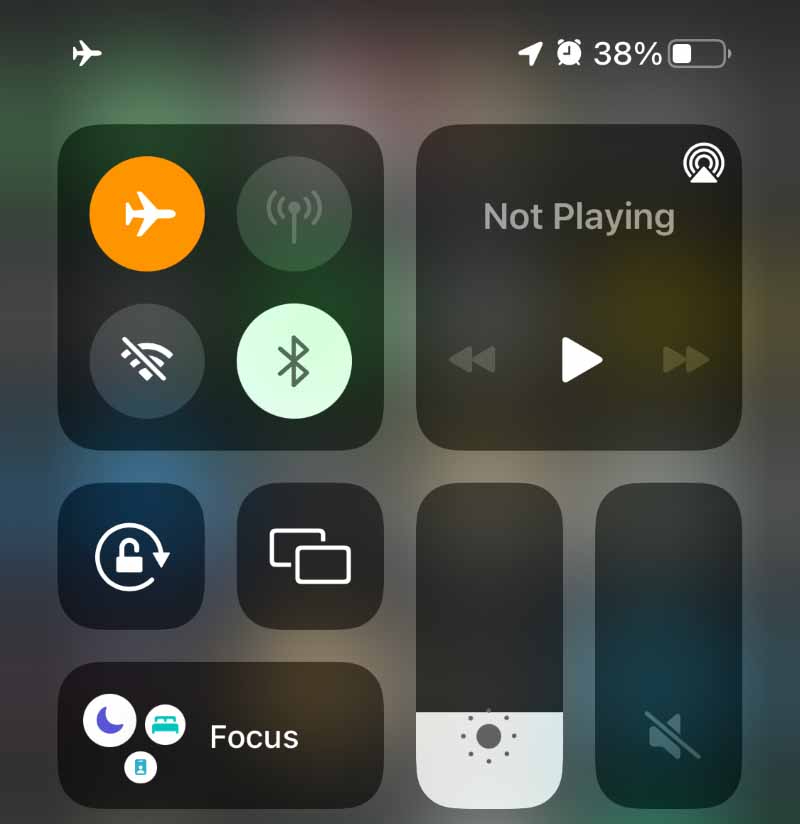
Remote Start Range Tip 5: Reduce RF Communication Interference
This one won’t apply to everyone, but it made a measurable difference in how far we could be from the car. This vehicle has a keyless entry system that automatically folds the mirrors out and activates the Genesis logo puddle lights when you approach the vehicle. This communication also serves to authenticate the remote in your pocket or purse with the security system in the vehicle so that all you have to do is press the button on the door handle to unlock the car. If we moved the factory key fob 10 feet away from the RF remote while testing, our range improved.
If you have a keyless entry system, you’ll want to keep that remote away from your remote starter or security system remote to maximize range.
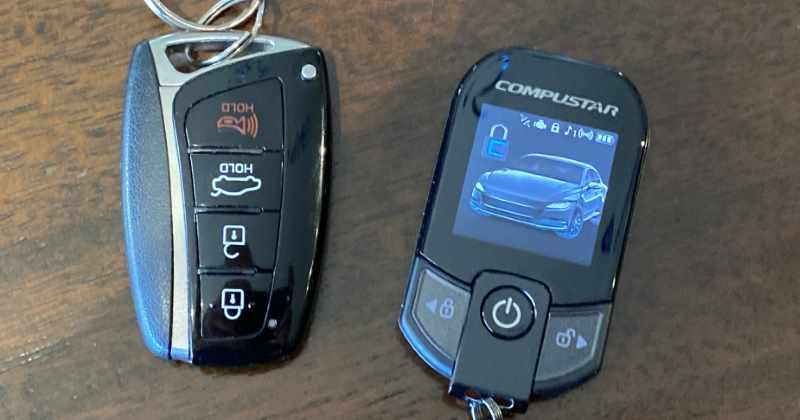
Remote Start Range Tip 6: Keep it Topped Up!
Our R5 and T13 remotes have built-in lithium-Ion rechargeable batteries. The T13 in particular was charged to full about a week ago and was showing three full bars of battery level at the end of this test. It’s possible to check the battery voltage when the remote is off by holding the start button for a couple of seconds. It reported a voltage of 3.848 volts. When charged to full, the voltage is closer to 4.2 volts.
We talked to one of our friends who is a rep for Compustar and he said the range doesn’t vary much unless the battery is quite low. Good to know. Two, this test was very real-world and was performed with the battery at measurably less than a full state of charge.
Purely for curiosity, we went out with the T13 remote fully charged to 4.156 volts, put the car in the same position and went for another 1.75-mile (2.8-kilometer) walk. The results were within 30 feet (10 meters) of being the same.
We have experience with more conventional remotes that use CR2032 lithium coin cells. As the battery voltage starts to drop, their range performance decreases. It’s not dramatic until the battery is very low, but if you’re trying to maximize performance, a fresh battery can help.
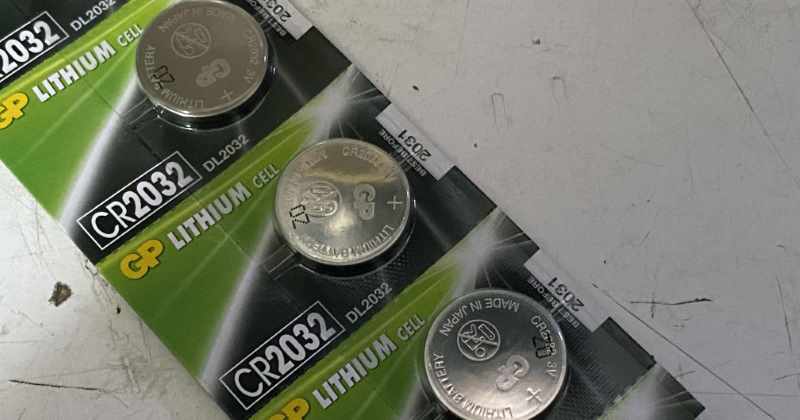
Why Do Car Starter Remotes Need This Much Range?
It was an 18-minute walk back to the car from where the remote stopped responding to confirmations from the vehicle. Nobody needs to remote start their car or truck 18 minutes before they get in it – that’s just a waste of fuel. Where range does matter is when you aren’t outside, or when there are obstacles between you and the vehicle. If you live in an apartment building or work in a hospital, factory or warehouse, then extra transmission power can be the difference between being able to start your vehicle from your desk or locker or having to wait until you’re outside and 30 seconds away from the car or truck. If the engine doesn’t have at least a few minutes to run before you get in, remote starting isn’t as beneficial.
Think of range as though it were describing signal transmission power – because it is. A remote with a higher rating is more likely to work from inside your favorite restaurant, a movie theater or a grocery store. Ideally, you want to give the vehicle at least two or three minutes to start warming up before you get to it. This will dramatically reduce how long it takes to start producing heat as you drive. Conversely, in the summer, this is enough time for the air conditioning to cool the car off and make getting in less uncomfortable.
Drop by your local specialty mobile enhancement retailer today to learn about the Compustar remote car starter options available for your vehicle. Be sure to pick a remote that will deliver the transmission power you’ll need so that you can always start your vehicle and let it warm up or cool off adequately. Once you have your starter, try these tips and tricks to maximize its range performance. If people look at you funny, well, welcome to the club!
